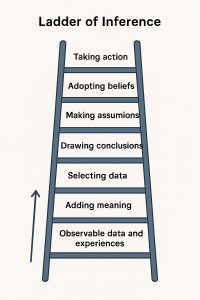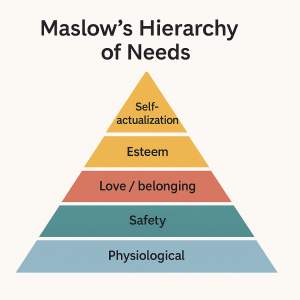Leadership has always fascinated me. Not because of the traditional image of a leader—standing at the top, commanding others—but because of the deeper question: what truly makes people follow someone with conviction and trust?
This question guided me throughout HEC Paris’s “Building Your Leadership Skills – For Credit” module, a program designed not to teach formulas of management, but to unlock an authentic and human approach to leadership. What I found was a journey that intertwined theory, practice, and self-reflection—one that reshaped how I think about leading others and, perhaps more importantly, how I lead myself.
In this article, I want to share some of the main insights from this learning experience: the Savoir-Relier method by Valérie Gauthier, the balance of reason and emotion in leadership, the 3Gs framework, perspectives from Simon Sinek and Maslow, and the Ladder of Inference as a practical tool for avoiding leadership blind spots.
Leadership Beyond Authority
When most of us picture leadership, the image that comes to mind is one of authority: someone at the top of a hierarchy making decisions. But one of the first lessons of the HEC module is that leadership is not about authority, it’s about influence, inspiration, and trust.
This is strongly echoed in Simon Sinek’s work, which we explored as part of the course. His famous idea, “Start with Why”, emphasizes that true leaders don’t begin with what they do or how they do it. They begin with why, a compelling reason that inspires others to join them.
- What leaders do: set goals, deliver projects, manage people.
- Why leaders inspire: they give meaning, purpose, and direction.
As Sinek argues, people don’t buy into what you do, they buy into why you do it. This aligns perfectly with the module’s view: leadership is not the power to control, but the ability to mobilize others through meaning.
The Savoir-Relier Method: Leading with Sense
The heart of the HEC module was Savoir-Relier, a methodology developed by Valérie Gauthier, Professor at HEC Paris. Savoir-Relier means “the ability to connect”—to link sense, self, and others through authentic relationships.
At its core, it rests on four pillars:
- Authenticity – Being true to yourself, embracing your values and imperfections.
- Empathy – The ability to deeply listen and connect with others’ emotions and perspectives.
- Coherence – Aligning words, actions, and values in a consistent way.
- Creativity – Leveraging differences and contradictions as sources of innovation.
Savoir-Relier is not just a theory; it is a practice. The module invited us to engage in one-on-one conversations, reflective writing, and group exercises where we explored vulnerability, conflict, and reconciliation.
The insight I carried from these exercises is simple but powerful: leaders are not defined by their titles, but by the quality of their relationships. The ability to build trust, resolve conflicts, and inspire collaboration is the real currency of leadership.
The 3Gs of Savoir-Relier Leadership
One of the most striking ideas from Valérie Gauthier’s book Leading with Sense is that effective leadership can be embodied through the 3Gs:
- Genuine – A genuine leader is authentic, transparent, and humble. They do not pretend to be flawless but instead embrace imperfection as a way to build trust. Being genuine means leading with honesty and showing others who you truly are.
- Generous – Generosity in leadership is not about giving for recognition; it’s about caring, sharing, and empowering others without expecting anything in return. A generous leader creates a safe space where people feel valued and supported.
- Generative – To be generative is to create and to innovate. A generative leader transforms experiences into opportunities for growth, encourages creativity, and inspires others to think beyond what exists today.
Together, the 3Gs form the backbone of savoir-relier leadership: leading with authenticity, with kindness, and with a forward-looking vision that unlocks new possibilities.
The Ladder of Inference: A Tool for Better Decisions

Another key concept introduced during the module is the Ladder of Inference, originally developed by Chris Argyris and Donald Schön. It illustrates how we move from observing reality to making decisions—often in ways that are unconscious, biased, or incomplete.
The steps of the ladder are:
- Observable data and experiences – What we see, hear, or sense.
- Selecting data – We notice certain details and ignore others.
- Adding meaning – We interpret what those details mean.
- Making assumptions – We fill in gaps based on our beliefs.
- Drawing conclusions – We decide “what’s true” based on those assumptions.
- Adopting beliefs – Our conclusions shape our worldview.
- Taking action – We act according to those beliefs.
The risk is clear: if we climb the ladder too quickly, we act not on reality, but on filtered data and assumptions. For leaders, this can mean jumping to conclusions about people or situations without checking the facts—damaging trust and decision-making.
The antidote is reflection and dialogue:
- Pause before climbing the ladder.
- Test your assumptions (“What else could explain this behavior?”).
- Seek multiple perspectives.
- Share your reasoning openly to invite feedback.
For me, this was a powerful reminder that leadership requires slowing down the thinking process, questioning our own mental models, and practicing humility in decision-making.
Balancing Sense and Sensibility
Another major theme of the course was learning to balance rational analysis with emotional intelligence. The readings “Sense and Savoir-Relier” and “Sense and Sensibility” emphasize that leadership is not about choosing between reason and emotion, but integrating both.
- Sense (rationality): Leaders need logic, clarity, and the ability to analyze complex situations.
- Sensibility (emotions): Leaders also need intuition, compassion, and awareness of the invisible dynamics within a group.
Too often, organizations overvalue sense while undervaluing sensibility. But the leaders we truly admire are those who know how to combine the two: they can read a balance sheet while also reading the room.
Revisiting Maslow: Needs and Motivation

One of the familiar but still powerful frameworks we revisited was Maslow’s hierarchy of needs. While often simplified as a pyramid of human needs (physiological → safety → belonging → esteem → self-actualization), Maslow’s model remains relevant for leadership because it reminds us that motivation is layered.
A leader cannot expect creativity and innovation from a team that does not feel safe or respected. Equally, high-performing employees will quickly disengage if they are stuck at the “esteem” level and denied opportunities for growth.
The key takeaway here is that leadership requires meeting people where they are, understanding their needs and creating the conditions for them to thrive.
Leadership in Action: Corporate and Entrepreneurial Perspectives
Throughout my career, whether working within large organizations or building my own company, I’ve seen these leadership lessons play out in very different contexts.
- In corporate environments, leadership is often about navigating complexity, aligning diverse stakeholders, and ensuring that projects move forward across multiple time zones and cultures. Here, coherence and empathy are essential: without them, trust erodes quickly.
- In entrepreneurial contexts, leadership is more about vision and resilience. Founders must inspire early believers, build credibility with investors, and cultivate the grit to navigate uncertainty. Here, the balance of sense and sensibility becomes crucial: strategy and analysis guide decisions, but intuition and passion fuel the journey.
In both settings, the most effective leaders are those who know how to create meaning for others, connecting “why,” “how,” and “what” into a compelling narrative.
Personal Takeaways
Looking back at this leadership module, I realize that its most valuable lesson was not a framework or a model, but a shift in mindset:
- Leadership is not a fixed trait—it is a practice of connection.
- Being a leader requires courage: courage to be authentic, to show vulnerability, to listen deeply, and to align actions with values.
- The journey of leadership begins with self-awareness. You cannot inspire others if you do not first understand your own “why.”
Since completing the module, I’ve tried to apply these lessons daily—whether by engaging in more intentional conversations with my teams, taking the time to reflect before making decisions, or focusing on coherence between my professional roles and my personal values.
Conclusion: Leadership as a Journey
Leadership is not a destination—it is a lifelong journey of learning, reflection, and growth. The HEC module “Building Your Leadership Skills” offered me not just academic insights but practical tools and personal awakenings.
If there is one message I would leave readers with, it is this: leadership is less about commanding others and more about connecting with them. It’s about weaving sense and sensibility, embracing vulnerability, and creating meaning that inspires others to join you.
And when practiced with the 3Gs—Genuine, Generous, and Generative, and guided by tools like the Ladder of Inference, leadership becomes not only effective, but transformative.




